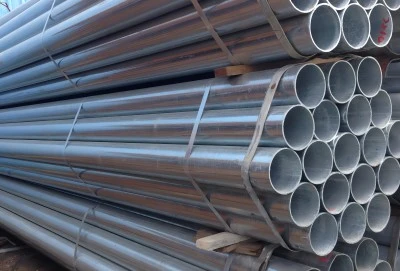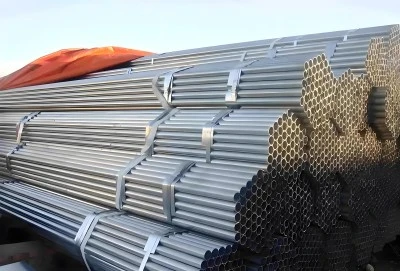Galvanized pipe has been a popular choice for water systems for decades, but its use in modern plumbing has become a subject of debate. While these pipes offer certain advantages, such as corrosion resistance and durability, they also come with potential drawbacks that need careful consideration.
|
|
|
Pros and Cons for Water Systems
Durability and corrosion resistance of galvanized pipes
Galvanized pipes are known for their impressive durability and corrosion resistance. The zinc coating applied through the hot-dip galvanization process creates a protective layer that shields the underlying steel from rust and corrosion. This protective barrier can significantly extend the lifespan of the pipes, making them a reliable option for water systems in various environments.
The corrosion resistance is particularly beneficial in areas with harsh water conditions or exposure to external elements. The zinc coating acts as a sacrificial layer, corroding before the steel underneath, which helps maintain the structural integrity of the pipe for longer periods. This characteristic makes galvanized pipes suitable for both indoor and outdoor applications, including water mains, fire protection systems, and irrigation networks.
Cost-effectiveness compared to other piping materials
When it comes to initial investment, galvanized pipes often present a more cost-effective solution compared to some alternative materials. The manufacturing process is well-established, leading to competitive pricing in the market. This cost advantage can be particularly appealing for large-scale projects or budget-conscious applications.
Moreover, the longevity can translate to lower long-term costs. Their durability means fewer replacements and repairs over time, potentially offsetting the initial investment. However, it's crucial to consider the total lifecycle costs, including potential maintenance and water quality issues that may arise with galvanized pipes in the long run.
Potential health concerns and pipe degradation over time
Despite their advantages, galvanized pipes are not without drawbacks. Over time, the zinc coating can degrade, leading to potential health and water quality issues. As the protective layer wears away, the underlying steel becomes exposed to water, which can result in rust formation and pipe corrosion.
This degradation process can lead to several problems. Firstly, it may cause a reduction in water flow as rust and mineral deposits accumulate inside the pipes. Secondly, and more concerning, is the potential for harmful substances to leach into the water supply. Older galvanized pipes, in particular, may contain trace amounts of lead, which can pose serious health risks if it enters the drinking water.
Water Quality Impact of Galvanized Pipes
Zinc leaching and its effects on water taste and safetyOne of the primary concerns with galvanized pipes is the potential for zinc leaching into the water supply. While zinc is an essential mineral for human health in small amounts, excessive intake can lead to adverse effects. The process of zinc leaching occurs gradually as water flows through the pipes, especially in areas with soft or acidic water.
The presence of excess zinc in water can result in a metallic taste, which may be noticeable to consumers. In some cases, it can also cause a cloudy appearance in the water. While these aesthetic issues are generally not harmful, they can affect the overall water quality and user experience. It's important to note that the rate of zinc leaching typically decreases over time as the galvanized coating stabilizes.
Lead contamination risks in older galvanized pipe systems
A more serious concern with older galvanized pipe systems is the risk of lead contamination. Before the 1960s, the galvanization process often involved the use of zinc that contained small amounts of lead. Over time, this lead can accumulate in the corroded areas of the pipes and potentially leach into the water supply.
Lead exposure, even in small amounts, can have severe health consequences, particularly for children and pregnant women. It can affect brain development, cause behavioral problems, and lead to other health issues. This risk is one of the primary reasons why many municipalities and homeowners are opting to replace old galvanized pipes with modern alternatives.
Regular water testing for homes with galvanized plumbing
For properties with galvanized plumbing systems, regular water testing is crucial to ensure water safety and quality. Comprehensive testing can detect the presence of excess zinc, lead, or other contaminants that may be leaching from the pipes. It's recommended to conduct these tests at least annually, or more frequently if there are concerns about water quality or if the plumbing system is particularly old.
Water testing can be done through local health departments, certified laboratories, or using home testing kits. The results of these tests can provide valuable information about the condition of your galvanized pipes and help determine if any remedial actions, such as pipe replacement or water treatment, are necessary to maintain safe drinking water.
Modern Alternatives for Water Plumbing
PEX piping: Flexibility and cost-effective installationCross-linked polyethylene (PEX) piping has emerged as a popular alternative to galvanized pipes in recent years. PEX offers several advantages, including flexibility, ease of installation, and resistance to freezing. Its flexibility allows for fewer joints and fittings, reducing the potential for leaks and making it ideal for retrofitting in existing structures.
PEX is also highly cost-effective, both in terms of material costs and installation labor. Its lightweight nature and flexibility mean it can be installed more quickly than rigid piping systems, potentially reducing overall project costs. Additionally, PEX is resistant to scale buildup and corrosion, which can help maintain consistent water quality over time.
Copper pipes: Long-lasting and bacteria-resistant option
Copper pipes have long been a staple in plumbing systems due to their durability and natural antimicrobial properties. Copper is highly resistant to corrosion and can last for decades when properly installed. It doesn't leach harmful chemicals into the water supply and can even help prevent the growth of harmful bacteria within the plumbing system.
While copper pipes may have a higher initial cost compared to some alternatives, their longevity and low maintenance requirements can make them a cost-effective choice in the long run. Copper is also fully recyclable, making it an environmentally friendly option for those concerned about sustainability in their plumbing choices.
Stainless steel: Premium choice for water quality
Stainless steel pipes represent a premium option for water systems where water quality is of utmost importance. Known for their exceptional durability and resistance to corrosion, stainless steel pipes can maintain their integrity even in challenging environments. They don't rust or leach contaminants into the water, ensuring consistently high water quality throughout their lifespan.
While stainless steel pipes come with a higher upfront cost, they offer unparalleled longevity and minimal maintenance requirements. This makes them an attractive option for critical applications or in settings where long-term reliability is essential. Stainless steel is also fully recyclable, aligning with sustainable building practices.
The decision to use galvanized pipe for water systems requires careful consideration of various factors. While galvanized pipes offer durability and initial cost-effectiveness, potential issues with water quality and long-term degradation cannot be ignored. Modern alternatives like PEX, copper, and stainless steel present compelling options, each with its own set of advantages. Ultimately, the choice depends on specific project requirements, budget constraints, and long-term goals for water quality and system performance. Consulting with plumbing professionals and conducting thorough water quality assessments can help in making the best decision for your water system needs.
Galvanized Pipe For Sale
Hebei Longma Group offers superior pipe solutions for various applications. Our state-of-the-art production facilities, equipped with advanced German technology, ensure the highest quality standards. With a team of over 300 skilled professionals, including 60+ technical experts, we deliver innovative and reliable piping solutions.
Our comprehensive testing facilities, including ultrasonic flaw detectors and industrial X-ray equipment, guarantee the integrity of every pipe we produce. We pride ourselves on fast delivery, with standard thickness pipes ready in as little as 7 days. Our products are backed by complete certifications, including API 5L, ISO 9001, and ISO 14001.
At Hebei Longma Group, we combine quality with competitive pricing, thanks to our integrated production model and strong relationships with raw material suppliers. For top-tier galvanized pipes that meet your project's demands, contact us at info@longma-group.com.














